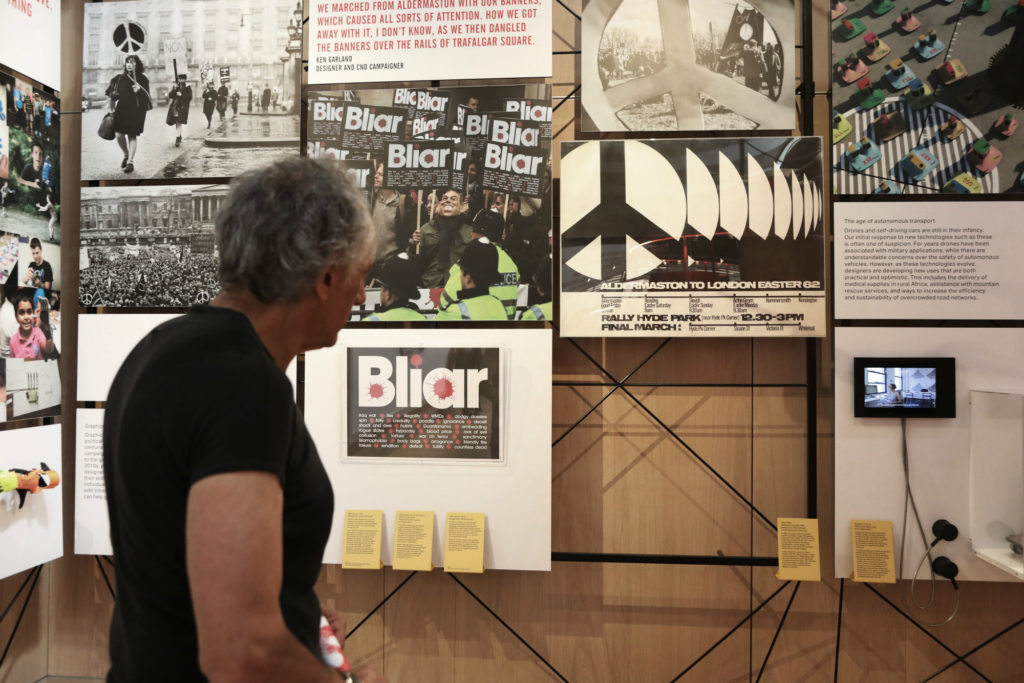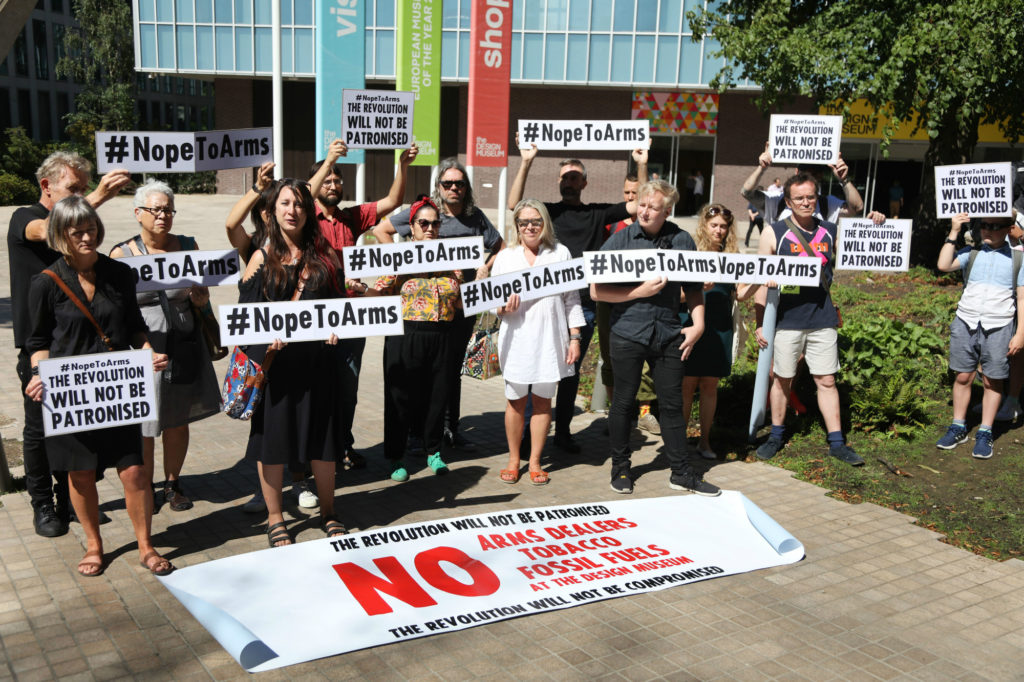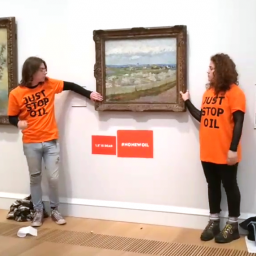Around a dozen artists and designers visited the Design Museum in London to remove their works in person today in protest of the institution’s decision to host a private reception for a company that produces military aircraft and weapons systems. While artists have a long history of protesting museum sponsors that don’t align with their values, the Design Museum demonstration—in which artists literally showed up and left with their art—is perhaps one of the most dramatic examples in recent memory.
The artists’ move comes just over a week after around 40 artists signed an open letter criticizing the museum’s decision to host the company, Leonardo, and asking that their works be removed by the end of the month. The corporate event was held on July 17 and coincided with the exhibition “Hope to Nope: Graphics and Politics, 2008–2018,” which explores the ways in which graphic design has influenced politics over the last decade.
The Design Museum did not immediately respond to a request for confirmation about the number of works withdrawn from the show. A-n News estimates that around a third of the exhibition has been removed.
“It is deeply hypocritical for the museum to display and celebrate the work of radical anti-corporate artists and activists, while quietly supporting and profiting from one of the most destructive and deadly industries in the world,” the artists stated in their letter.
So far, the museum’s directors Deyan Sudjic and Alice Black have been critical of the demonstrations. They suggest they were spearheaded by “professional activists” who do not have close ties to the museum. “We will not be seen as an easy target and a surrogate for the real targets of these campaigners,” they wrote in a letter posted to the museum’s website. “We do not want our programs to be co-opted by the agenda of others and we stand by our curatorial independence.”

Peter Kennard removed his work from the Design Museum in solidarity. Photo by Kristian Buus.
Artist Peter Kennard, a professor of political art at the Royal College of Art in London, was deeply troubled by this response. He said he removed his work from the museum’s permanent display partly in solidarity with the many younger artists who lent work to the temporary exhibition.
“The gallery’s reaction has been to demean the artists, when they talk of outside agitators,” he tells artnet News. In his view, the notion that the exhibition’s participating artists—many of whom are politically engaged activists in their own right—need guidance from professional agitators is “totally ridiculous.” He adds: “[The museum’s directors] can’t relate to the artists whose work they put on show. They have treated them despicably, which is why I took my piece down.”
The museum swiftly added new labels to the empty walls co-signed by the embattled museum chiefs. The label notes that the works have been removed at the lenders’ request because they objected to a private event by “an aerospace and defense company” at the museum and apologizes that the protest has “impacted the visitor experience.”
The 40 artists and designers who have asked their work to be withdrawn have formed a group called the Nope to Arms Collective, a play on the show’s title. They describe Leonardo as the “ninth biggest weapons producer in the world.”
In a joint statement, the directors say that the museum has committed to review its policy for private events and will not host defense, fossil fuel, or tobacco companies during this period. But they conclude that “the long-term impact of these protests will be to reduce the work that we do, which is designed to benefit the sector and the wider public.”

Peter Kennard calls the Design Museum’s stance “horrendous” and has removed his work from its permanent display. Photo by Kristian Buus.
Kennard calls Sudjic and Black’s statement “horrendous.” He says: “You can’t say you need arms companies to raise money, there are other ways. It’s not reason to have jollies for companies that make weapons.”
He contends that the museum’s directors have failed to respect artists who agreed to present their work for free in an exhibition that charges admission. But he takes cold comfort in the fact that the museum has agreed to keep the depleted exhibition open for free for its final 10 days. “There’s a lot of blank walls,” Kennard says.
Read the Design Museum directors’ statement in full below.
Our exhibition Hope to Nope: Graphics and Politics 2008-18 tells the story of political protest in the last ten years, assessing the role of social media on political activism and how graphic design has evolved in this context.
This exhibition has been a popular and critical success, with over 30,000 visitors to date. It presents a range of views, from across the political spectrum. Our objective was never to side with any party or world view, but to show how different sides have expressed their beliefs, through design.
As an educational charity, we cannot take an overt political stance as some activists would like us to do. Recent events have shown us that breaching the laws that regulate charities could put us at risk of having our charitable status removed. In a statement today the Charity Commission reminded the charities sector that, “educational charities can play an important role in informing the public. The law is clear, however, that they must do so in a balanced and neutral way. There are clear rules for charities regarding political activity that form a key part of both charity law and public expectations.”
On Tuesday 17 July the Design Museum atrium was hired by a company in the aerospace and defence industry for a private event. Professional activists whose work didn’t feature in the exhibition took the view that the museum had acted wrongfully and were quick to exploit the situation.
The museum is now being targeted by a group of activists, not all of whom are being accurate in their presentation of the situation. We are in the midst of an argument not of our making. We will not be seen as an easy target and a surrogate for the real targets of these campaigners. We do not want our programmes to be co-opted by the agenda of others and we stand by our curatorial independence.
The Design Museum policies are in line with those of all other major cultural institutions around the world. These haven’t changed since the exhibitors agreed to be part of the exhibition. We have committed to review these policies and those that apply for event hire at the museum. The outcome of these protests will be to censor the exhibition, curtail free speech and prevent the museum from showcasing a plurality of views.
The museum has entered into a dialogue with exhibitors to keep the exhibition intact for the public to continue to see its broad message. We have committed to not having such private hires while we take time to discuss the issues with our peers in the sector and review if any of our policies need to be updated.
We are a charity which receives barely 2% of its funding from the public purse, we work hard to raise the income to support our exhibition and learning programmes. The long term impact of these protests will be to reduce the work that we do which is designed to benefit the sector and the wider public.
Deyan Sudjic and Alice Black
DIRECTORS OF THE DESIGN MUSEUM
“Hope to Nope: Graphics and Politics, 2008–2018” is on view at the Design Museum, 224-238 Kensington High Street, London, through August 12, 2018.











